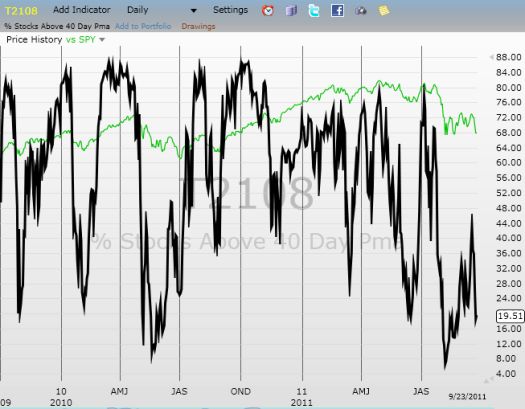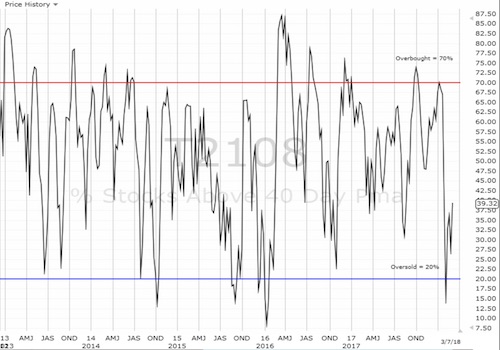(T2108 measures the percentage of stocks trading above their respective 40-day moving averages [DMAs]. To learn more about it, see my T2108 Resource Page.)
T2108 Status: 21% and “almost” oversold.
General Trading Call: Continue covering shorts. Add more small long positions.
Commentary
T2108 dropped to 21%, right on the edge of the official 20% oversold threshold. Interestingly enough, the S&P 500 maintained a flat close. This sets up a potential bullish divergence that is the exact opposite of the bearish divergence we saw on Thursday. That bearish divergence preceded Friday’s 1.4% plunge in the S&P 500. If the stock market gaps down on Tuesday, I want to buy aggressively for swing (short-term) trades. T2108 will be below 20% at that point, and I will expect the market’s “rubber band” to get stretched as far as it is going to go on the downside for the immediate-term. If the market gaps up, I will be thankful I have been adding some longs and covering most of my shorts in preparation for a good oversold bounce. I will not decide on a next move until reviewing the action after the close.
Friday’s trade following the bullish call action in Bank of America (BAC) stock is doing well so far. Traders flocked to June 11 calls over June 11 puts once again. Today’s ratio was almost 4-to-1. (I will post any future trade on this position on twitter with the #120trade hastag).
Today’s trading delivered some fascinating correlations with currency trading. It was a clear reminder that cheap dollars do matter to asset prices and can in turn motivate/trigger others to re-evaluate price perceptions – contrary to Federal Reserve Chairman Ben Bernanke’s insistence that the dollar has an insignificant impact.
Soon after lunchtime ended on the East Coast, the S&P 500 took a steep dive, hitting a hard bottom for the day within minutes. In parallel, the dollar index had finally stabilized, creating a bullish divergence for the stock market. That is, for most of the morning, the dollar appreciated while the stock market slipped. Within one hour, the dollar suddenly and sharply reversed course while the stock market roared to life again. After the dollar stabilized again, the stock market slowly drifted back to flatline. Whatever automated trading programs were at work went into hyperdrive, likely rapidly allocating funds across asset classes. This is just one possible explanation of the burst of activity and the just as sudden dissipation of volatility.
The chart below uses UUP, the PowerShares DB U.S. Dollar Index Bullish Fund, as a proxy for the dollar index to show the close association between the dollar and the stock market (represented by the ETF SPY). I added the ETF for the Australian dollar (FXA – Rydex CurrencyShares Australian Dollar Trust ETF – still my favorite currency) because it is treated as a commodity currency and often trades inversely to the U.S. dollar. Note the unmistakable close correlation to the stock market on an intraday basis today.

Source: Yahoo!Finance
Today’s action was a great reminder of why we must always keep one eye open for what is happening in the currency markets.
Charts below are the latest snapshots of T2108 (and the S&P 500)
Refresh browser if the charts are the same as the last T2108 update.
Daily T2108 vs the S&P 500

Black line: T2108 (measured on the right); Red line: S&P 500 (for comparative purposes)
Weekly T2108

*All charts created using TeleChart:

Related links:
The T2108 Resource Page
Expanded daily chart of T2108 versus the S&P 500
Expanded weekly chart of T2108
Be careful out there!
Full disclosure: long SSO puts, long FXA, net short U.S. dollar, long BAC calls
